Jeremie Averous's Blog, page 127
November 30, 2013
How We Moved from Analytic to Appreciative Thinking
Peter Block in his book “Flawless Consulting” – one of the bibles on consulting – makes the point that between the different editions of the book which spanned from the early 1990′s to the 2010′s, the following evolution happened in consulting – and more generally in problem solving:
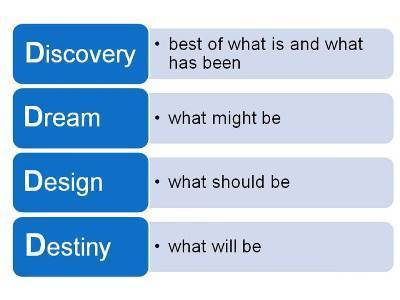
Appreciative Improvement at work: the 4D. Starting from what works instead of from the problem
in the 1990′s (and before) it was all analytically driven
in the 2000′s it was about “whole group participation”, i.e. getting groups of people transverse to the organization and representative of all levels defining and implementing solutions (in a very Total Quality Manner)
in the 2010′s it is about “positive deviance” – also called appreciative inquiry, i.e. finding those few areas which work much better (instead of focusing on the problem) and figuring out what is making the difference. This has spread in coaching as well as more general solution finding and implementation.
This is an excellent summary of how we have moved into the Fourth Revolution: from the analytic perspective of the Industrial Age into increased collaboration and finally into creative development of isolated successes.
In what stage is your organization and life at the moment? What about moving into appreciative improvements?

November 28, 2013
Culture Is The Way We Do Things Around Here When No-One Is Looking
This is a great definition given by Des Power, the HSEQ director of one of my clients’, during a workshop. I love it.
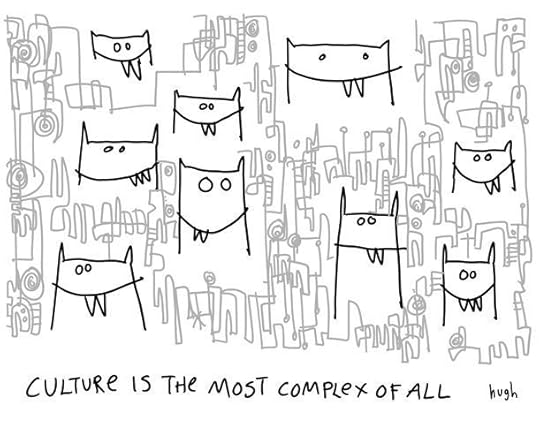 It just reminds us that culture is complex, difficult, but that it is all about behavior and in particular, behavior when no-one is looking.
It just reminds us that culture is complex, difficult, but that it is all about behavior and in particular, behavior when no-one is looking.
Re-read our post on a great sample of applied Fourth Revolution culture for a refresher on how that can be achieved in advanced organizations!
Hat tip to Des Power and Hugh MacLeod for the illustration

November 26, 2013
When to Decide That a Goal is Not Meant to be Reached
“A goal is not always meant to be reached, it often serves simply as something to aim at” is a famous Bruce Lee quote.
We need to be able to let go when we don’t reach our goals but progress towards them has been sufficient.
 Some people don’t have goals. They err aimlessly in the world and will never get anywhere.
Some people don’t have goals. They err aimlessly in the world and will never get anywhere.Some other people have goals and will be relentless until they reach them. Sometimes these people are visionaries that suffer from never reaching their goals. Or, they suffer when they reach their goal and figure out they are not satisfied. They might be producing great things but remain frustrated.
Some other people have goals, and know when to decide that progress has been sufficient and that they now need to update their goals, without reaching their original aim. How can they decide this change without feeling regrets of changing path without having accomplished their quest? One simple criteria applies: when the new goal is more exciting and appears more fulfilling than the previous goal.
Don’t change goal every other day, but recognize that only excitement and passion will drive you to do new stuff. If you find a new goal that is more compelling to the point that the previous goal looks dull and unattractive, switch. And, above all, don’t feel regrets and let go of any that might remain.

November 24, 2013
Update after a Technical Glitch for Email Subscribers
I was just made aware of a technical glitch that affected our feed and our email subscribers since Nov 7. This is now solved. Here are the great posts since that date that you might have missed:
Project Soft Power Presentation (full video)
It’s not about Work-Life Balance, it’s about Work-Life Integration
Creativity and Design by Subtraction
What’s Your Presentation’s Single Message?
How the Subscription Economy is Spreading, Killing Ownership Further
Re-imagining Work – Fourth Revolution applied (Video)
The Job of a Leader is to Grow More Leaders
Or visit simply the blog page.
Apologies for this glitch, I had to remove a post which apparently contained a character that was not recognized by the feed processor.
Have a great week ahead!
Kudos to Olivier Lareynie for highlighting the issue!

November 23, 2013
Project Soft Power Presentation (full video)
I gave a speech on Project Soft Power: Become a Great Project Leader at the 2013 Singapore Project Management Institute Symposium, which has been recorded.
I am proud to share the video which we’ve edited with the slides as well included so as to give the best experience if you could not attend:
If you can’t see the video, here is the link.
Many thanks to SPMI for making the video available! O riginal video is (c) SPMI and the content is (c) Project Value Delivery, 2013.
November 21, 2013
It’s not about Work-Life Balance, it’s about Work-Life Integration
This is a quote of Tony Hsieh, Zappos CEO, as related by Hugh McLeod. Hugh continues: “Work and personal life seems to meld together in a way that can be either enhancing or debilitating – and it is up to each person to structure what works in their life and in ways that allow them to be their best in work and at home. What is interesting is that this is a new phenomenon, borne out of technology.”
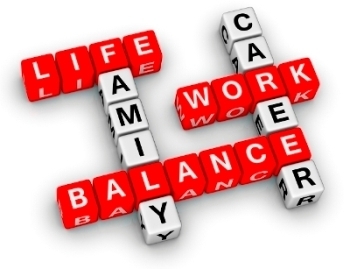 Work-Life balance is a typical concept stemming from a time where work and life were happening in different environments, separated by the barrier of commuting. This geographical border has now been abolished by technology. Work has already heavily invaded our private home, and life increasingly (but with more difficulties due to old habits) invades a bit our work.
Work-Life balance is a typical concept stemming from a time where work and life were happening in different environments, separated by the barrier of commuting. This geographical border has now been abolished by technology. Work has already heavily invaded our private home, and life increasingly (but with more difficulties due to old habits) invades a bit our work.
Visionaries try to develop new spaces where life and work could co-exist harmoniously (this seems to be one of the objectives of Tony Hsieh’s Las Vegas downtown project that allies urban and social experiment).
We need to stop these obsolete and pervading considerations about work-life balance and concentrate on how we can integrate these two activities. In fact, they are not antagonistic but in synergy and we need to recognize that better. Once we look at it that way, a world of possibilities opens.
What about you? What do you see when you consider that work and life are in fact integrated and will become ever more integrated?
November 19, 2013
Creativity and Design by Subtraction
I bumped into a few references to the fact that creation and design is often powerfully achieved by subtraction.
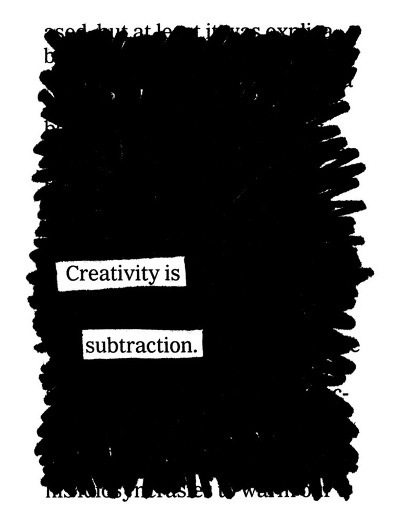
Creativity is subtraction, by Austin Kleon
In “Perfect Pitch“, a book about how to present advertising concepts and ideas, Jon Steel mentions his “belief that creativity is not, as many people believe, a process of invention from nothing. Instead, it is a painstaking exercise in reduction, of removing all the bits that don’t look like a great idea“. He uses the example of the unhewn rock that the sculptor will transform into a masterpiece.
Similarly, this quote of Jonathan Ive, the famous Apple designer: “A lot of what we seem to be doing in a product like [the iPhone] is actually getting design out of the way. And I think with that sort of reason — and they’re not just arbitrary shapes — it feels almost inevitable. It feels almost undesigned. It feels almost like, “Well, of course it’s that way. Why would it be any other way?”" (hat tip to Valeria Maltoni in this Conversation Agent post).
Maybe instead of constantly trying to add features to our lives and products we should take a deep breath and take out everything which is not indispensable – and thereby create great value. What do you think?
The picture is by Austin Kleon, an excellent writer on the topic of creativity, in books such as Newspaper Blackout or Steal Like An Artist.
November 16, 2013
What’s Your Presentation’s Single Message?
That’s a question I often ask to people who ask me to advise or coach them and I am often met with blank stares. Even after a long winding presentation that lasted a few hours. It is the most important question: if you don’t what’s your message, how can you expect to have communicated it properly?!?
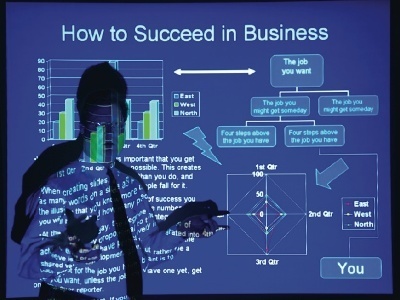
So, what’s the message?
Yes, you need to have one message. One SINGLE message that pervades your entire presentation from start to finish.
Remember that law of presentations by Jon Steel in Perfect Pitch: “The more separate points you attempt to make, the less your audience will take in“.
It might be tough to restrict yourself to one single message that you’ll wave in and out of your presentation, in particular if you feel like it is the single opportunity you will have to express yourself in front of a particular audience.
Yet, what do you prefer: one single message that is noticed and remembered, or a presentation that will soon be forgotten?
Make your choice. One single well-crafted message for the next presentation will take the day. Ready to try?
November 14, 2013
How the Subscription Economy is Spreading, Killing Ownership Further
Further to our successful blog post on The End of Ownership, John Warrillow proposes an interesting alternate view on the development of the Subscription Economy.
Increasingly, successful companies propose to clients to pay a subscription instead of buying individual items. John identifies 5 main business types associated with a subscription business model:
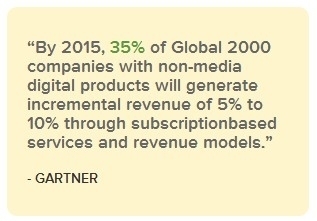 flat fee to access an unlimited library of content,
flat fee to access an unlimited library of content,sampling boxes,
automatic replenishment of consumables,
monitoring (e.g. antivirus etc),
reporting – access to information.
The most interesting evolution lies in the first type. Unlimited libraries of content have only been made possible through the Fourth Revolution. It looks increasingly like subscription is the model of the future for access to cultural and artistic products, leveraged by powerful algorithms that suggest further products based on what you have been using. It is the typical model of Netflix for video, and it seems that Amazon and online music broadcasters increasingly tend towards this model.
For example, Amazon Kindle proposes a program where customers can borrow titles and authors get compensated from an Amazon pot, proportionally to the popularity of their books.
Hence, not only do we own less and rent more, but the rent increasingly looks like a flat fee for a service, relatively independent of the usage intensity. A great business model that will further reinforce our dependence on rental.
November 12, 2013
Re-imagining Work – Fourth Revolution applied (Video)
This excellent video from RSA Animate features Dave Coplin, Chief Envisioning Officer at Microsoft, explaining the future of Work – how it shifts with the digital revolution.
This video gives another perspective on the fact that Work as we were envisioning it in the Industrial Age is going to be deeply transformed by the Fourth Revolution: “The ways we live our working life today has become outdated“. And, it mentions how the concept of productivity is obsolete – not only obsolete – “it is fast becoming the problem“. The video also presents some interesting considerations on office space!
Plus, you’ll really enjoy the great illustrations as usual with RSA talks!
If you can’t see the video, follow this link.
Hat tip to Valeria Maltoni for this nugget. In her post she adds more comments on how she sees the future of work – in particular, that “One thing is for sure, a culture of openness remains scary for most organizations, as well as the people who work in them.” Interesting thought!



